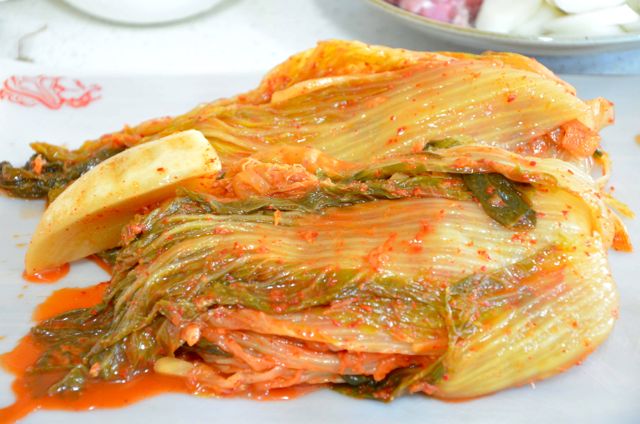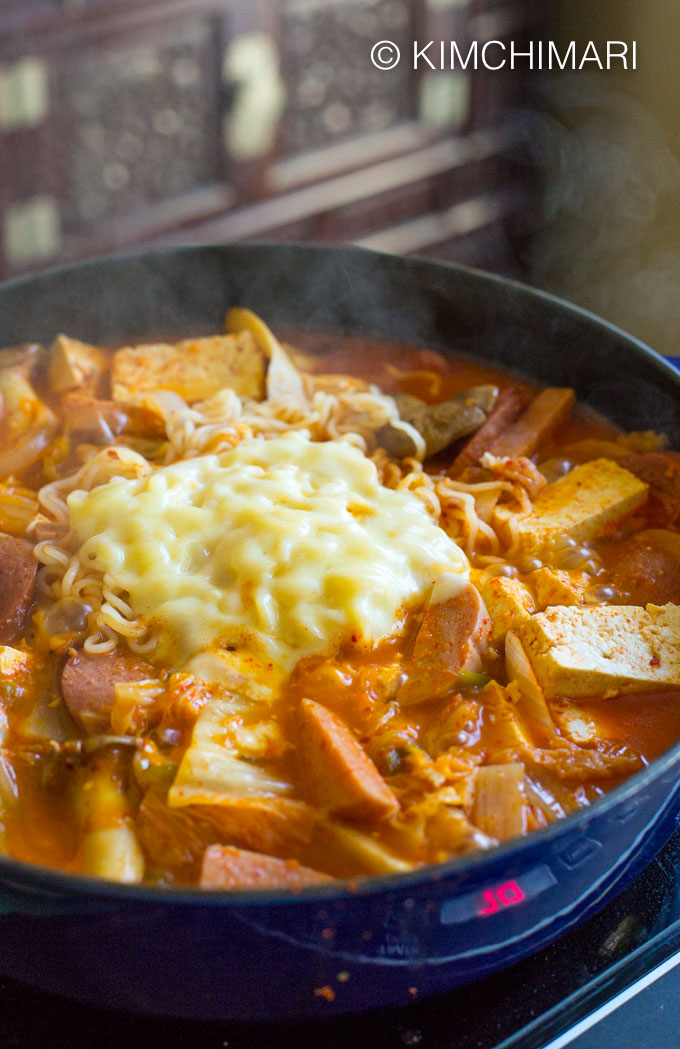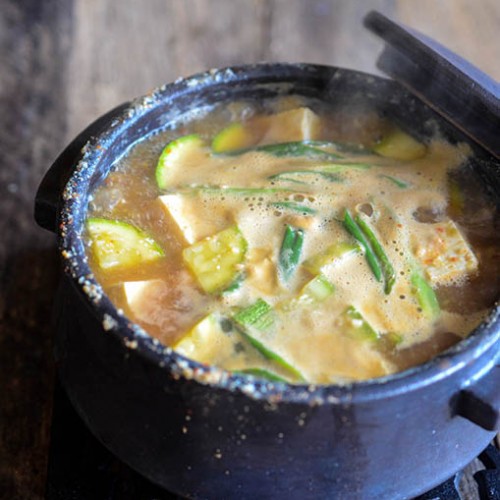Budae Jjigae (Korean Army Stew) is a wonderfully hearty kimchi stew that has become really popular since its creation after the Korean war. If you love Kimchi, this is a MUST-TRY EASY dish.

The History of Budae Jjigae
After the Korean war, the US military stayed behind and setup bases in several locations throughout Korea. Usually near these bases, one could buy American products -especially canned foods like, yes, the infamous SPAM!!
So what to do with SPAM? Well..what else? Add Kimchi!! Kimchi makes everything taste better!! And so this Kimchi Army Stew (aka 부대찌게 – pronounced Boo-Dae Jjigae) was born.
The word Budae means Army Base in Korean and by now you know Jjigae means stew. That’s why it is translated as Korean Army Stew or Korean Army Base Stew. This dish is still very popular today and most Koreans say the area for the best Budae Jjigae is actually 의정부 (Uijeongbu) -the place of origin.
One memory I have about SPAM and other American goodies is that even when I was a kid (in the late 60’s early 70’s, many years after the war) this one lady (ajoomas) came to our house and secretly sold various foods that were basically smuggled out of the army bases.
I remember getting excited every time this 양키 아줌마 (Yankee Ajooma – haha.. get it? ) would visit, to see what yummy goodies came out of her bag! Because, at that time, things like peanut butter, grape jelly, SPAM, American Kraft Cheese singles, corn beef, baked beans and chocolates were not available anywhere else but only through her.
What makes an Awesome Budae Jjigae?
- Over ripened, sour kimchi makes the best kimchi jjigae and budae jjigae. Here’s a pic of my Kimjang kimchi in August which means it is over 10 months old!

Sour whole cabbage kimchi from Kimjang – fermented for 10 months Notice how the flesh has become kind of translucent – this is a definite sign that the kimchi has become quite sour. Normally you don’t want to buy this unless you are buying overly ripe, old kimchi (묵은지 Mookeunji) on purpose to make stews or fried rice.
- Don’t skimp on kimchi – some make it with very little kimchi but I like my budae jjigae to have plenty of kimchi because otherwise the deli meats can overpower in flavor.
- Fatty spam and sausages are a must – I know spam and sausages are not the healthiest food and I try not to eat it most of the time but for this, it just doesn’t happen without spam and/or sausages. Hot dog sausages or Keilbasa sausages work the best.
- It has to be thoroughly cooked. Don’t eat it too soon before it has time to fully cook with the kimchi cabbages soft and the flavors have all melded together. It actually tastes even better the next day.
Cook’s Tips for Perfect Budae Jjigae (Korean Army Stew)
- What kimchi to use for Korean Army Stew? It is best to use sour kimchi but if you can’t, add a bit of vinegar. If the kimchi is too sour for your taste, add a bit of sugar. 1 tsp or so should do the trick.
- Why is my Budae Jjigae bland? Different Kimchi recipes have different seasoning levels. If it taste too bland, add more Korean chili powder and/or gochujang and sometimes even garlic powder.
- What kind of Kimchi can I use for Budae Jjigae? Only Cabbage? Cabbage kimchi works best but you can mix in Radish Kimchis like kkakdugi, seokbakji or chongak kimchi.
- For Variations, add any or all of the following:
- American or medium cheddar cheese slice on top
- ramen noodles – add dried noodles to pot during cooking. Add extra water because noodles absorb a lot of water (If you think you will have leftovers, my advice is not to add ramen noodles because they will continue to soak up the broth).
- baked beans
- bacon
- chrysanthemum leaves (쑥갓 sookat)
- mushrooms
- Storage: Budae Jjigae will keep for days in the fridge and tastes even better when reheated the next day. Leave out noodles or rice cakes when storing. It also tastes strangely good at room temp with hot rice – when you don’t feel like going through the trouble of reheating.. 🙂
Step-by Step Directions
- If you have a whole cabbage kimchi (like above) then cut the kimchi into slices like so. If you have an already sliced kimchi (mak kimchi), then you don’t need to cut it any further.

Kimchi sliced for Budae Jjigae - Cut green onions, onions, tofu, sausages, spam like so –

Budae Jjigae (Korean Army Stew) Ingredients - Get a pot or skillet and layer bottom with Kimchi and then all remaining ingredients on top except for garlic. Pour water, cover and start cooking on Med High heat until it starts to boil. Lower heat and simmer for 15 min.

Budae Jjigae ingredients and water in pot – all ready to cook! 
Here’s a different, updated version – Budae Jjigae ready to cook in pot with kielbasa, ramen noodles, cheese and mushrooms added! - Here’s how it looks after it’s been cooking for 15 min.

BudaeJjigae after boiling for 15 min - Now, mix it with a big spoon so the gochujang is evenly mixed throughout. And it will almost immediately look like this –

BudaeJjigae cooked 15min and mixed - Add chopped garlic, cover and simmer for another 10 min or so. Taste the broth and adjust if necessary. (See my Tips above on how to adjust flavors) And it should be ready to eat!~ :))

Budae Jjigae all cooked and steaming!
Serving Suggestion
Serve Budae Jjigae in individual bowls with rice, or cook and enjoy it at the table like a hot pot. For a more elegant look, try my idea of serving rice and stew together in one bowl. Best side dishes are mild tasting side dishes like stir fried string potatoes served with mayonnaise. It smoothes out your taste buds in between this explosively delicious stew!

☆ Did you make this recipe? I hope you can give me a 5 star rating below!
And leave me a comment to let me know how you like it! I’d LOVE to hear from you! 😍
You can also FOLLOW ME on FACEBOOK, PINTEREST and INSTAGRAM or join my FACEBOOK GROUP to see other Korean recipes to ask and share everything about Korean food with others just like you!
FOR WORDPRESS FOLLOWERS only – PLEASE DON’T FORGET to SIGN UP with your email if you are a wordpress follower because, after this post, I will ONLY BE updating followers that have signed up with my new email sign up form (also on my home page) and no longer via wordpress.
Thank you and Enjoy! ❤
JinJoo
Budae Jjigae (Korean Army Stew)
Ingredients
- 4 cups cabbage kimchi sliced
- 1/2 can SPAM (sliced)
- 2 hot dog sausages (sliced)
- 4 oz ground pork
- 4-6 oz extra firm tofu (sliced)
- 1 green onion (sliced)
- 1 onion (sliced)
- 1 Tbs chopped garlic
- 2/3 cups rice cake slices (optional)
- 3 cups water
- 1 Tbs gochujang (Korean red chili paste)
Instructions
- Prepare ingredients by washing, cutting, and slicing.
- Get a pot or skillet with a cover and first layer Kimchi at the bottom and then the remaining ingredients on top except for the garlic. Pour water, cover and start cooking on med high heat until it starts to boil. Lower heat and simmer for 15 min.
- Add the chopped garlic and simmer for another 10 min or so. Taste the broth and adjust if necessary. If it’s too sour, add a little bit of sugar. For more spicy or stronger flavor, add more gochujang and garlic.
Tips & Notes:
- Budae Jjigae keeps well in the fridge and tastes even better when reheated. Just be sure to leave out noodles or rice cakes when storing. It also tastes good cold with hot rice – when you don’t feel like going through the trouble of reheating.
- For variations, you can add one or more of the following:
- a slice of American cheese on top
- ramen noodles – just add dried noodles to the pot in the middle of cooking. Be sure to add more water because noodles will absorb a lot of water (If you think you will have leftovers, don’t add ramen noodles to the pot since the noodles will continue to soak up any excess liquid)
- baked beans
- bacon
- chrysanthemum leaves (sookat)
Nutrition Information:
UPDATE NOTES – This recipe was originally published August 2013 but was re-published with updated photos and more cooking tips in June 2018.























This looks so good! I would love to make it and add corn 🙂 I bet the broth tastes amazing with rice. And now I realize a lot of the kimchi I’ve tried has been sour (!). Would love to taste the broth with steak too.
Oh yes – it’s a must with rice. It’s going to be yummy however you make it – as long as the kimchi is fully ripened as you know already!
This is a wow recipe! We enjoyed this delicious stew with the kimchee, spam, tofu, and noodles. Will certainly make it again!
So happy to hear that!! It’s my go-to stew whenever I feel like cooking something simple but satisfying!! Thank you!